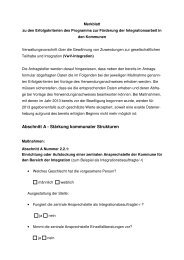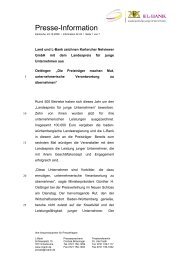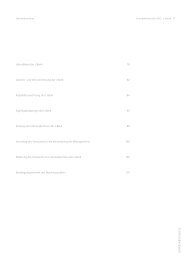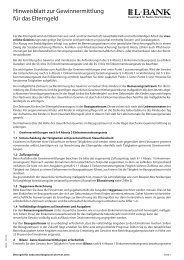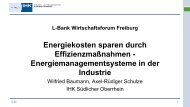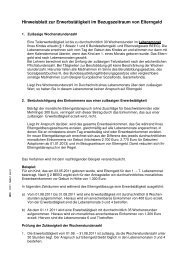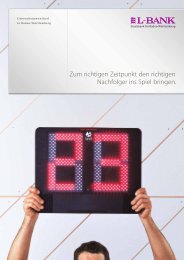Landeskreditbank Baden-Württemberg - L-Bank
Landeskreditbank Baden-Württemberg - L-Bank
Landeskreditbank Baden-Württemberg - L-Bank
Create successful ePaper yourself
Turn your PDF publications into a flip-book with our unique Google optimized e-Paper software.
number of complete years to maturity from the issue date or (y) 15% of the total noncontingent principal<br />
payments and (b) it provides for stated interest, paid or compounded at least annually, at current values of (i) one<br />
or more qualified floating rates, (ii) a single fixed rate and one or more qualified floating rates, (iii) a single<br />
objective rate, or (iv) a single fixed rate and a single objective rate that is a qualified inverse floating rate.<br />
A current value of a rate is the value of the rate on any date that is no earlier than three months prior to the<br />
first day on which that value is in effect and no later than one year following that first day. A “qualified floating<br />
rate” is any variable rate where variations in the value of such rate can reasonably be expected to measure<br />
contemporaneous variations in the cost of newly borrowed funds in the currency in which the Variable Debt<br />
Security is denominated. Although a multiple of a qualified floating rate will generally not itself constitute a<br />
qualified floating rate, a variable rate equal to the product of a qualified floating rate and a fixed multiple that is<br />
greater than .65 but not more than 1.35 will constitute a qualified floating rate. A variable rate equal to the<br />
product of a qualified floating rate and a fixed multiple that is greater than .65 but not more than 1.35, increased<br />
or decreased by a fixed rate, will also constitute a qualified floating rate. In addition, under the OID Regulations,<br />
two or more qualified floating rates that can reasonably be expected to have approximately the same values<br />
throughout the term of the Variable Debt Security (e.g., two or more qualified floating rates with values within<br />
25 basis points of each other as determined on the Variable Debt Security’s issue date) will be treated as a single<br />
qualified floating rate. Notwithstanding the foregoing, a variable rate that would otherwise constitute a qualified<br />
floating rate but which is subject to one or more restrictions such as a maximum numerical limitation (i.e., a cap),<br />
a minimum numerical limitation (i.e., a floor) or a restriction on the amount of increase or decrease in the stated<br />
interest (i.e., a governor) may, under certain circumstances, fail to be treated as a qualified floating rate under the<br />
OID Regulations unless such restrictions are fixed throughout the term of the Debt Security or are reasonably<br />
expected not to affect the yield on the Debt Security significantly. An “objective rate” is a rate that is not itself a<br />
qualified floating rate but which is determined using a single fixed formula and that is based on objective<br />
financial or economic information. A rate will not qualify as an objective rate if it is based on information that is<br />
within the control of the issuer (or a related party) or that is unique to the circumstances of the issuer (or a related<br />
party), such as dividends, profits, or the value of the issuer’s stock (although a rate does not fail to be an<br />
objective rate merely because it is based on the credit quality of the issuer). An objective rate is a “qualified<br />
inverse floating rate” if the rate is equal to a fixed rate minus a qualified floating rate, as long as variations in the<br />
rate can reasonably be expected to inversely reflect contemporaneous variations in the qualified floating rate. The<br />
OID Regulations also provide that if a Variable Debt Security provides for stated interest at a fixed rate for an<br />
initial period of one year or less followed by a variable rate that is either a qualified floating rate or an objective<br />
rate and if the variable rate on the Variable Debt Security’s issue date is intended to approximate the fixed rate<br />
(e.g., the value of the variable rate on the issue date does not differ from the value of the fixed rate by more than<br />
25 basis points), then the fixed rate and the variable rate together will constitute either a single qualified floating<br />
rate or objective rate, as the case may be.<br />
If a Variable Debt Security that provides for stated interest at either a single qualified floating rate or a<br />
single objective rate throughout the term thereof qualifies as a variable rate debt instrument under the OID<br />
Regulations and if the interest on such Debt Security is unconditionally payable in cash or property (other than<br />
debt instruments of the issuer) at least annually, then all stated interest on such Debt Security will constitute<br />
qualified stated interest and will be taxed accordingly. Thus, a Variable Debt Security that provides for stated<br />
interest at either a single qualified floating rate or a single objective rate throughout the term thereof and that<br />
qualifies as a variable rate debt instrument under the OID Regulations will generally not be treated as having<br />
been issued with original issue discount unless the Variable Debt Security is issued at a “true” discount (i.e., at a<br />
price below the Debt Security’s stated principal amount) in excess of a specified de minimis amount. The amount<br />
of qualified stated interest and the amount of original issue discount, if any, that accrues during an accrual period<br />
on such a Variable Debt Security is determined under the rules applicable to fixed rate debt instruments by<br />
assuming that the variable rate is a fixed rate equal to (i) in the case of a qualified floating rate or qualified<br />
inverse floating rate, the value as of the issue date of the qualified floating rate or qualified inverse floating rate,<br />
or (ii) in the case of an objective rate (other than a qualified inverse floating rate), a fixed rate that reflects the<br />
yield that is reasonably expected for the Variable Debt Security. The qualified stated interest allocable to an<br />
71



